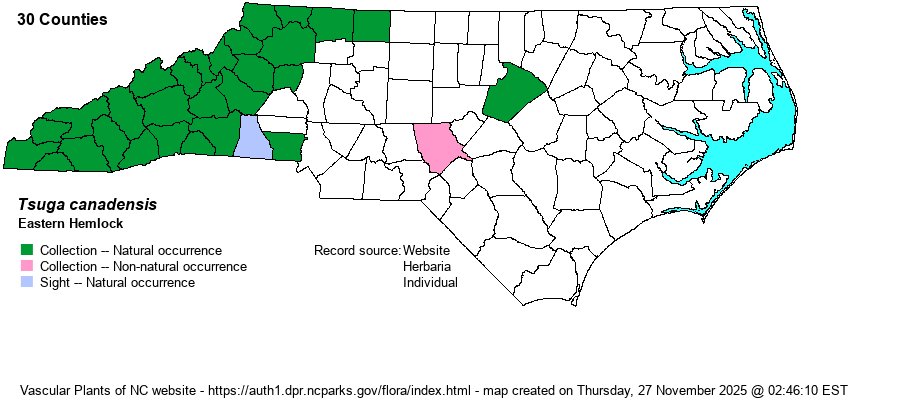| Author | (L.) Carriere | |
| Distribution | Throughout the Mountains and western Piedmont, though in the latter region found mostly in foothills and cool slopes. Strangely and famously disjunct to a single preserve (Hemlock Bluffs) in Wake County in the eastern Piedmont. Sadly, most mature trees in NC are dying or are now dead, owing to the hemlock wooly adelgid (insect), and even the seedlings are being attacked by the insect, as well. Its future status in the state is not known, but there is the possibility of it becoming extirpated in the state in the next several decades. Planted and locally established in in various Piedmont and Sandhills counties, but these are not mapped, except for Moore.
A Northern species ranging from N.S. to southern Ont. south to NJ, PA, and IN; thence south mainly in the Appalachians to northern GA and northern AL. The adelgid has impacted trees from the southern end of the range north at least to southern New England; so far, Canada and OH westward seem to be free of this pest, for now.
| |
| Abundance | Formerly very common throughout the Mountains, and common in the western Piedmont; essentially absent from the eastern two-thirds of the Piedmont, except for trees in Wake County (Hemlock Bluffs). Currently, still technically common but very strongly declining everywhere in the state; most trees are now dead or dying, though in a few areas in the western Piedmont one can still see trees not yet affected by the adelgid. Trees in Wake County, and in some places in the Mountains, have been sprayed to protect them from the adelgids, at least temporarily. It has now been added by the NC NHP to its Watch List, owing to the severe decline. As a result of the strong decline in the state, this website has changed the State Rank up to [S4], from the NC NHP's S4S5. This rank could easily be claimed by some to be S3 or even S2 given its rather perilous condition now.
Thomas et al. (2021) re-inventoried the Wake County population and compared it with the 1952/53 inventory. While overall numbers of plants (seedlings, saplings, adults) were very similar, the 2021 authors found high levels of seedling mortality and low levels of seedling germination. They suggested that this change was due to deer browse, Woolly Adelgid predation, increased canopy closure, and increased ambient temperature. | |
| Habitat | It favors cool microclimates of stream banks, ravines, shaded or north-facing slopes, and other non-xeric sites. It may grow on some steeper or rockier slopes, but that is where the similar Carolina Hemlock (T. caroliniana) grows. Even when it was unaffected by the adelgid, hemlocks typically grew scattered among hardwoods or Eastern White Pines (Pinus strobus), and seldom grew in extensive stands. |
| Phenology | Pollen is shed in March and April, and cones mature from September to November. | |
| Identification | This very familiar tree is sadly disappearing from the state. It is (was) a medium to large tree, growing to 80-100 feet tall, but few such trees are alive in the state now. The overall shape is a cone or pyramid, like a Red Spruce (Picea rubens), and like that species has a shaggy look as opposed to a clean pyramid of Fraser Fir (Abies fraseri). The evergreen needles are flat, rounded at the tip, and quite short – only about 1/2-2/3-inch long. Needles are arranged in a flat spray and are not arranged spirally in several planes. The cones are quite small, less than 1 inch long, and hang down from the branches. The quite similar Carolina Hemlock has needles somewhat longer, needles arranged randomly scattered on a twig (and not in a single flat plane), and has larger cones. Red Spruce has sharp needles that are square in cross-section. | |
| Taxonomic Comments | None
| |
| Other Common Name(s) | Canada Hemlock is almost equally used, as is the other form of the name – Canadian Hemlock. | |
| State Rank | S4S5 [S4] | |
| Global Rank | G4G5 | |
| State Status | W5 | |
| US Status | | |
| USACE-agcp | FACU link |
| USACE-emp | FACU link |

